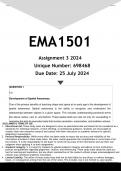EMA1501
Assignment 3 2024
Unique Number: 698468
Due Date: 25 July 2024
QUESTION 1
1.1.
Development of Spatial Awareness
One of the primary benefits of teaching shape and space at an early age is the development of
spatial awareness. Spatial awareness is the ability to recognize and understand the
relationships between objects in a given space. This includes understanding positional terms
like above, below, next to, and behind. These spatial skills are vital not only for succeeding in
geometry but also for everyday tasks that involve navigation, organization, and problem-solving.
DISCLAIMER & TERMS OF USE
1. Educational Aid: These study notes are designed to serve as educational aids and should not be considered as a
substitute for individual research, critical thinking, or professional guidance. Students are encouraged to
conduct their own extensive research and consult with their instructors or academic advisors for specific
assignment requirements.
2. Personal Responsibility: While every effort has been made to ensure the accuracy and reliability of the
information provided in these study notes, the seller cannot guarantee the completeness or correctness of all
the content. It is the responsibility of the buyer to verify the accuracy of the information and use their own
judgment when applying it to their assignments.
3. Academic Integrity: It is crucial for students to uphold academic integrity and adhere to their institution's
policies and guidelines regarding plagiarism, citation, and referencing. These study notes should be used as a
tool for learning and inspiration, but any direct reproduction of the content without proper acknowledgment and
citation may constitute academic misconduct.
4. Limited Liability: The seller of these study notes shall not be held liable for any direct or indirect damages,
losses, or consequences arising from the use of the notes. This includes, but is not limited to, poor grades,
academic penalties, or any other negative outcomes resulting from the application or misuse of the information
provided.
]
, For additional support +27 81 278 3372
QUESTION 1
1.1.
Foundation of Geometric Understanding
Shape and space are fundamental concepts in the field of geometry, and their importance in
emergent mathematics cannot be overstated. In the Foundation Phase curriculum, these
concepts are often collectively referred to as "Space and Shape," underscoring their
interconnectedness. Shape and space lay the groundwork for more advanced mathematical
topics, such as algebra, calculus, and trigonometry, by helping young learners grasp the basic
ideas of geometry.
Development of Spatial Awareness
One of the primary benefits of teaching shape and space at an early age is the development of
spatial awareness. Spatial awareness is the ability to recognize and understand the relationships
between objects in a given space. This includes understanding positional terms like above,
below, next to, and behind. These spatial skills are vital not only for succeeding in geometry but
also for everyday tasks that involve navigation, organization, and problem-solving. Young
learners who develop strong spatial awareness are better prepared to understand more complex
geometric and mathematical ideas later on.
Enhancement of Visual and Tactile Learning
Shape and space education engages both visual and tactile learning styles. Children learn by
seeing different shapes and recognizing their properties—such as the number of sides and
angles. They also benefit from tactile experiences where they handle physical objects, build
shapes, and physically navigate through obstacle courses. These hands-on activities make
abstract concepts more concrete, helping to solidify understanding and facilitate memory
retention. They are also instrumental in enhancing fine motor skills, which are crucial for writing
and other detailed tasks.
Vocabulary and Language Development





